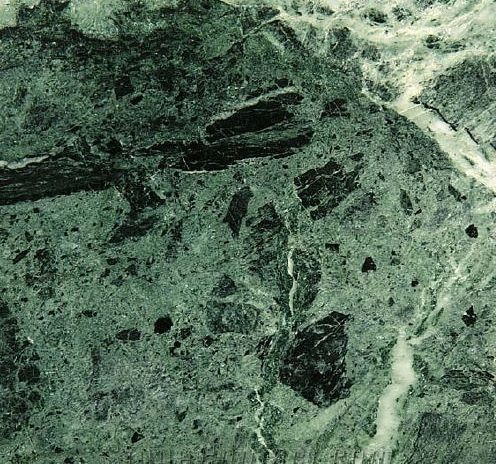I marmi verdi della Valle d’Aosta
The green marbles of Valle d'Aosta
- 01 Apr 2018

Caratteristiche geologiche e petrografiche
Oficalciti composte da clasti di serpentinite in una matrice di serpentina verde chiaro e calcite, interamente attraversate da vene di calcite bianca.
Principali caratteristiche tecniche
I marmi serpentini verdi della Valle d’Aosta sono relativamente nuovi arrivati a confronto di quelli dell ‘area di Genova (“Verde Polcevera”), ma sono tra i più familiari del XX sec.
Prima del 1920-1930, l’attività estrattiva in Valle d’Aosta era minima, ma il settore decollò dopo la Seconda guerra mondiale e raggiunse la massima produzione negli anni Sessanta. Un piccolo numero di cave produce ancora marmo esportato in tutto il mondo. La pietra è presente in numerose varietà, ma nel commercio è difficile correlarne i nomi con le caratteristiche esteriori. Le più conosciute sono le seguenti. Il “Verde Issorie” è una pietra di colore grigioverde chiaro con piccoli frammenti sparsi di serpentinite scura e abbondanti vene fratturate di calcite bianca. Il “Verde Aver” è simile, ma privo di frammenti scuri di serpentinite. Per contro, il “Verde Patrizia” (verde Patricia) contiene abbondanti clasti di serpentinite scura arrotondati o spigolosi in una matrice verde chiara e bianca, anch’essa percorsa da venature fratturate di calcite bianca. Il “Verde St. Denis” mostra frammenti tondi di serpentinite verde scura su un fondo da verde chiaro a bianco, mentre il “Verde Gressoney”, ottenuto da scavi sotterranei a Gressoney St. Jean, è una breccia particolarmente fine di serpentina scura in una matrice verde molto chiara.
Il “Verde Patrizia” fu utilizzato all’inizio del Novecento per rivestire le facciate dei negozi Cartier.
Attualmente risultano estratti limitatamente e saltuariamente.
Applicazione: Soprattutto per uso in interni, pavimentazioni , ri vestimenti di pareti e altri elementi architettonici
Fonti:
“Atlante delle pietre decorative” – T.Price Ed. Hoepli
 Arch. Anselmo Santilli – ZEDPROGETTI srl
Arch. Anselmo Santilli – ZEDPROGETTI srl
Geological and petrographic characteristics
Oficalcytes composed of snake clasts in a matrix of light green serpentine and calcite, entirely crossed by white calcite veins.Main technical features
The green serpentine marbles of Valle d’ Aosta are relatively new arrivals compared to those of the Genoa area (“Verde Polcevera”), but they are among the most familiar of the XX century.
Before 1920-1930, the mining activity in Valle d’ Aosta was minimal, but the sector took off after the Second World War and reached its maximum production in the 1960s. A small number of quarries still produce marble exported all over the world. Stone is present in many varieties, but in the trade it is difficult to correlate its names with its external characteristics. The most well-known are the following. The “Issorie Green” is a light grey-green stone with small fragments scattered with dark serpentinitis and abundant veins fractured with white calcite. The “Aver Green” is similar, but without dark fragments of serpentinitis. On the other hand,”Verde Patrizia” (Patricia green) contains abundant clasts of dark serpentinite rounded or angular in a light and white green matrix, also covered by fractured veins of white calcite. The” Verde St. Denis” shows round fragments of dark green serpentinitis on a light green to white background, while the “Verde Gressoney”, obtained from underground excavations at Gressoney St. Jean, is a particularly fine breach of dark serpentine in a very light green matrix.
The “Verde Patrizia” was used at the beginning of the twentieth century to cover the facades of Cartier shops.Application: Especially for indoor use, flooring, wall and other architectural elements

